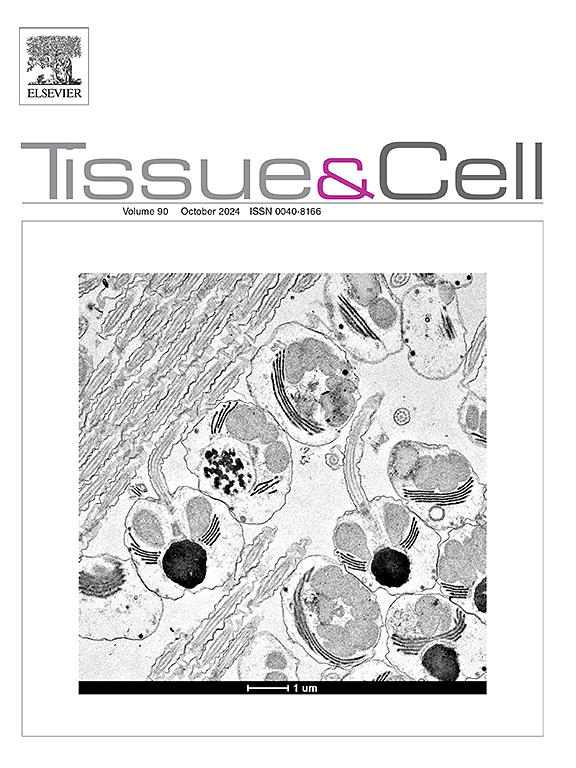Daxas provides renoprotective effects in ischemia-reperfusion injury by targeting apoptosis, oxidative stress, and inflammation pathways
IF 2.7
4区 生物学
Q1 ANATOMY & MORPHOLOGY
引用次数: 0
Abstract
Background and aim
The pathophysiology of renal ischemia-reperfusion injury (IRI) is a multifaceted process involving various pathways, including oxidative stress and inflammatory responses. This study was designed to evaluate the renoprotective effect of Daxas, Roflumilast (RFL), a selective phosphodiesterase 4 (PDE4) inhibitor, in preventing IRI consequences in rats.
Methods
Fifty-four rats were split up into three groups: the sham group, which did not experience any ischemia; the IRI group, which underwent renal IRI for 45 minutes; and the Daxas-treated group, which received 1.2 mg/kg after IRI. At 2, 5, and 7 days, blood and kidney samples were collected to assess renal histopathology, oxidative stress indicators, apoptosis, inflammatory gene analysis, and kidney function.
Results
The outcomes showed that renal IRI significantly impaired kidney function. Furthermore, in a comparison with the sham group, IRI significantly raised the levels of oxidative stress marker malonaldehyde (MDA) in the kidney while significantly decreasing the activities of glutathione (GSH), catalase (CAT), and superoxide dismutase (SOD) at 2, 5, and 7 days (p < 0.05). In comparison to the Sham group, IRI also caused a drop in Bcl2 and Nrf2 and an increase in BAX, MPO, IL-6, and TNF-α at the different time intervals (p < 0.05). At different time points, treatment with Daxas significantly improved all of these metrics when compared to the IRI group (p < 0.05). Immunohistochemical examination of BAX demonstrated a substantial elevation in the IRI group relative to the sham group (p < 0.05), concentrated in tubular epithelial cells and inflammatory infiltrates. Daxas therapy markedly decreased BAX expression to levels akin to the sham group (p < 0.05).
Conclusions
Daxas demonstrated potent kidney-protective benefits by reducing oxidative stress, enhancing renal function, and modifying inflammatory and apoptotic pathways. According to these results, Daxas may be a viable treatment choice for reducing the consequences of IRI.
Daxas通过靶向细胞凋亡、氧化应激和炎症途径在缺血-再灌注损伤中提供肾保护作用
背景与目的肾缺血再灌注损伤(IRI)的病理生理是一个涉及多种途径的多层面过程,包括氧化应激和炎症反应。本研究旨在评估选择性磷酸二酯酶4 (PDE4)抑制剂罗氟米司特(RFL) Daxas对大鼠IRI的保护作用。方法54只大鼠随机分为3组:假手术组,无缺血;IRI组,肾脏IRI持续45 分钟;daxas治疗组,IRI后给予1.2 mg/kg。在第2、5和7天,采集血液和肾脏样本,评估肾脏组织病理学、氧化应激指标、细胞凋亡、炎症基因分析和肾功能。结果肾IRI对肾功能有明显损害。此外,与假手术组相比,IRI显著提高了肾脏中氧化应激标志物丙二醛(MDA)的水平,同时在第2、5和7天显著降低了谷胱甘肽(GSH)、过氧化氢酶(CAT)和超氧化物歧化酶(SOD)的活性(p 和lt; 0.05)。与Sham组相比,IRI还引起不同时间间隔Bcl2、Nrf2水平下降,BAX、MPO、IL-6、TNF-α水平升高(p <; 0.05)。在不同的时间点,与IRI组相比,Daxas治疗显著改善了所有这些指标(p <; 0.05)。免疫组化检查显示,与假手术组相比,IRI组BAX明显升高(p <; 0.05),BAX集中在小管上皮细胞和炎症浸润中。Daxas治疗显著降低BAX表达至与假手术组相似的水平(p <; 0.05)。结论daxas通过降低氧化应激、改善肾功能、调节炎症和凋亡通路,显示出强大的肾保护作用。根据这些结果,Daxas可能是减少IRI后果的可行治疗选择。
本文章由计算机程序翻译,如有差异,请以英文原文为准。
求助全文
约1分钟内获得全文
求助全文
来源期刊

Tissue & cell
医学-解剖学与形态学
CiteScore
3.90
自引率
0.00%
发文量
234
期刊介绍:
Tissue and Cell is devoted to original research on the organization of cells, subcellular and extracellular components at all levels, including the grouping and interrelations of cells in tissues and organs. The journal encourages submission of ultrastructural studies that provide novel insights into structure, function and physiology of cells and tissues, in health and disease. Bioengineering and stem cells studies focused on the description of morphological and/or histological data are also welcomed.
Studies investigating the effect of compounds and/or substances on structure of cells and tissues are generally outside the scope of this journal. For consideration, studies should contain a clear rationale on the use of (a) given substance(s), have a compelling morphological and structural focus and present novel incremental findings from previous literature.
 求助内容:
求助内容: 应助结果提醒方式:
应助结果提醒方式:


